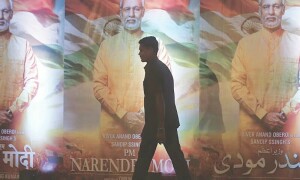“To orchestrate a fashion week,” says Sehyr Saigol, chairperson of the Pakistan Fashion Design Council (PFDC), “one has to take risks, set new precedents and if some egos get provoked by this, then so be it.”
Having just wrapped up the eighth PFDC Sunsilk Fashion Week (PSFW), and along with their bridal weeks, this makes it its 12th fashion edition to date, the council has seen its fair share of tarnished egos, hitches and occasional scandal and yet always managed to stick to its pre-determined fashion week calendar.
“We keep changing our policies in order to discipline and guide the industry further,” says Sehyr. At the PSFW this time, there was a clear demarcation in the schedule between luxury prêt, high street and textile shows. In the past, retail-friendly high street and fabric shows, was sandwiched in between high fashion luxe had made fashion weeks appear mish-mashed. One had been prone to twiddle thumbs or better yet, takes umpteen front-row selfies, until the showcase ended!
Now, separate shows for each category allowed for fairer, balanced critique. High street brands competed with each other, as did fabric. One could appreciate Generation’s funky take on animal prints and Beech Tree’s pretty geometrics, comparing them only with the other high street players.
Or in the fabric shows, be bowled over by the ethnic beauty and absolute wear-ability of Shubhinak’s line-up. Earlier, everything else paled in comparison to the glamour of luxury- prêt.
And yet, this change in schedule couldn’t have gone down well with the high street and textile big shots. Sehyr doesn’t mince her words, “They’re all clever enough to know that more people will come to see their show if it’s featured alongside the work of popular designers.”
When necessary, Sehyr is known to rule her council with an iron fist … but she is also known to nurture talent
Wasn’t she wary that the council may lose out on lucrative showcases?
“It was a risk that had to be taken,” shrugs Sehyr. “We can’t lose vision and cater to everybody’s demands. Textile brands have often tried to masquerade as designer wear, professing that their collections are created by in-house design teams. I tell them that they are welcome to try out for the luxury- prêt slots but then, I would be judging them in comparison with the bona fide designer creations.
If they aren’t up to par, they won’t be allowed a slot at all. It’s surprising how many cringe and complain and yet, we’ve had a strong list of participants showcasing in our textile and fabric categories.”
Another battle of wills she faces every fashion week is with the contenders for the grand finale, a coveted slot that is often saved for PFDC ‘favorite’ HSY.
“Allowing HSY to open or close a fashion week is a sensible decision and has nothing to do with favoritism,” says Sehyr. “Nobody can deny the kind of crowd that he draws in and the drama and star power he has on stage.”
True to form, the self-declared ‘Couture King’ paraded his ‘Ink’ line-up for the finale this time; an eclectic mix of Asian influences fashioned into kimono sleeves, jackets and tunics cinched at the waist and men in quirky versions of the sherwani.
Aside from HSY, though, many of the council’s more illustrious designers were missing from the PSFW line up this year. Sara Shahid of ‘Sublime’, Maheen Kardar Ali’s ‘Karma’ and Khadijah Shah’s ‘Elan’ all opted out, perhaps having been too busy creating capsules for last month’s Sawrovski Couture Weekend to assemble spring/summer lines in time for PSFW.
Another PFDC regular, Ali Xeeshan, was not allowed onto the catwalk due to his skirmish with media personnel at last October’s PFDC Bridal Couture Week. “Unfortunately, sometimes certain people have to be sacrificed in order to set down rules,” says Sehyr.
“Ali needed to realize that he can’t show unless he knows how to deal with the press. Designers need to curb their temper tantrums and appreciate how hard we have worked to establish our credibility. This is why Ali was not part of the Swarovski Couture Weekend and why he isn’t part of this time’s PSFW.”
When necessary, Sehyr is known to rule her council with an iron fist … but she is also known to nurture talent. The PSFW line up may not have boasted all of the council’s usual suspects but it brought in exciting, scintillating fashion statements from unexpected new territories.
Young names, groomed and guided by the council, came into their own: Saira Shakira and Zonia Anwaar presented collections that were absolute head turners while ‘Teena’ by Hina Butt traversed retail-friendly truck art inspirations. Even the debut shows were well-crafted.
Natasha Kamal showed promise with her three-dimensional ruffled dresses and the Bank Alfalah Rising Talent entourage, for once, was savvy and eye-catching. One couldn’t help but compare it with the costumery exhibited on the Bank Alfalah platform just weeks ago at the Telenor Fashion Pakistan Week (TFPW).
There were others: Misha Lakhani with her minimalistic anglicized glamour, Nida Azwer Atelier’s Iznik accents on saris, jackets and pants, Zara Shahjahan’s fitted waistcoats, Sania Maskatiya’s elegant take on organza and fairytale detailings, Sana Safinaz’s vivacious brilliant prints and Muse, putting together jigsaw puzzles of stripes, pleats and sequins to create absolute stunners.
Amir Adnan’s menswear was well-tailored and Republic presented a line of suits, managing to steal the show with their showstopper, actor Fawad Khan. These are all, however, well known labels that often deliver.
It is the mark of a fashion forward council to promote new talent and push new boundaries. PFDC did that very well this time. There were the unavoidable mundane collections but there was nothing atrocious … and even the boring designs were redeemed to some extent by the impeccable styling by Nabila’s N-Pro team, official stylists for the PSFW.
“If a designer genuinely works hard, I am there to support him or her and to give my suggestions,” says Sehyr. Post-fashion week, designers are allowed free exhibition space at the PFDC Boulevard store in Lahore, allowing them to retail or take orders on hot-off-the-runway designs. It highlights the importance of retail following fashion week, an initiative also addressed by the Karachi-based Fashion Pakistan Council, with prompt exhibits following TFPW this year.
Sehyr, though, is also looking into making Pakistani designers available to India through an online portal. “India”, she says Sehyr, “is a lucrative, most applicable market for Pakistani fashion right now.
Pakistani fashion is not ready to take on Western export but India makes sense. It’s why we set up the PFDC Boulevard store in Delhi.” It’s also why one no longer sees a Hilary Alexander sitting in the audience. Instead, there was a Nivedita Sharma covering the event for IANS.
Undeniably, the store in Delhi has suffered quite a few hiccups but it is still up and running. Another not-so-lucky store, the PFDC Boulevard in Karachi, closed down ultimately. “We try different things and sometimes we succeed and sometimes we don’t,” allows Sehyr.
“The store in Delhi is coming along but having said that, our key role is hardly to play retailer for designers. We provide them a platform through fashion week and it is up to them to grasp subsequent retail opportunities.”
The latest initiative to be taken up by the council, as announced on the final day, is a Design District bringing together designers, textile mills and indigenous craftsmen. “Our craft is what is unique to us,” observes Sehyr. “It is what foreigners come to see in Pakistan — not just the indigenous embroideries used in our apparel but also our jewelry, carpets, furniture and lawn.
Fine tuning and making our craft available to the market locally and eventually, internationally, is something that I have wanted to do for the longest time. The PFDC plans to bring in artisans from all over Pakistan, pay the expenses for the duration for which they are here and put them in contact with designers who can take their work to the next level by spinning it into current designs and ensuring quality control.”
Another project on the cards is the setting up of a Textile Museum, displaying classics from Pakistan’s textile heritage and progressing to the textures and cuts of today. “It’s what we absolutely need as a country with a huge textile-oriented business,” points out Sehyr.
Usually, what Sehyr — and the PFDC — plan to do, they manage to achieve. PSFW this time had moments of fascinating fashion and set forth new stars in the business … perhaps there are many more to come.
Published in Dawn, Sunday Magazine, April 26th, 2015
On a mobile phone? Get the Dawn Mobile App: Apple Store | Google Play













































